A comprehensive macaron troubleshooting guide with photos, possible causes and how to avoid the most common macaron issues!
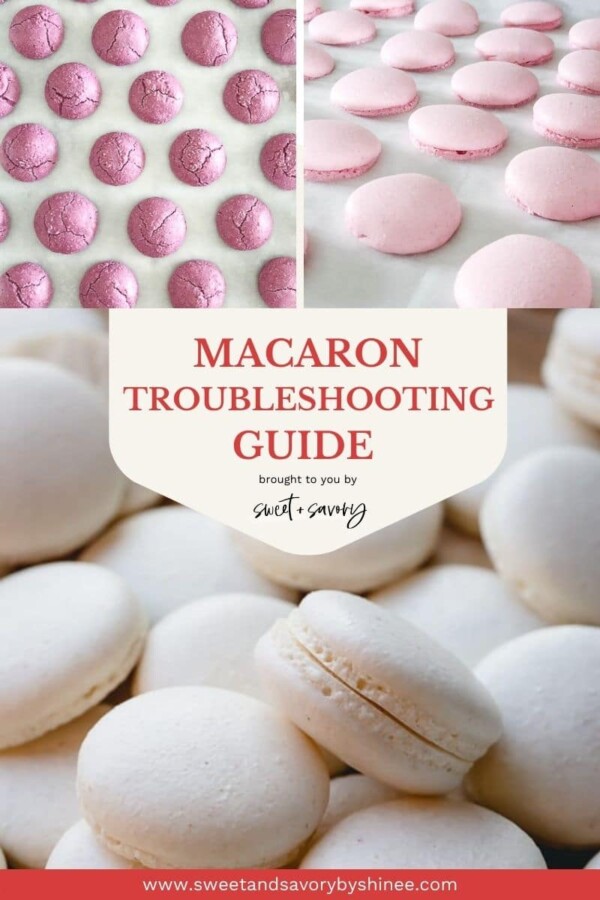
Table of Contents
Since 2012, I’ve made thousands of macarons in my home kitchen with many trials and errors, as well as picture-perfect macarons! And yes, I’ve had pretty much every problem imaginable!!
In the process, I’ve gained lots of tips and tricks to solve those frustrating issues and, most importantly, how to avoid them in the first place.
Remember, sometimes, macarons fail for no apparent reason and leave us scratching our heads.
But I encourage you to never give up on macarons. The joy of watching your macarons grow those ruffled feet and pulling out perfectly round macarons with shiny smooth tops is simply priceless.
I swear, every single time, when I see my macarons through the oven door puffing up and baking perfectly, I can’t help but do a little happy dance in my kitchen! Pure joy, I’m telling ya!
What’s a perfect macaron?
Perfect macaron is very subjective. To me, a perfect macaron has the following characteristics:
- Smooth shells
- Ruffles feet
- Full inside
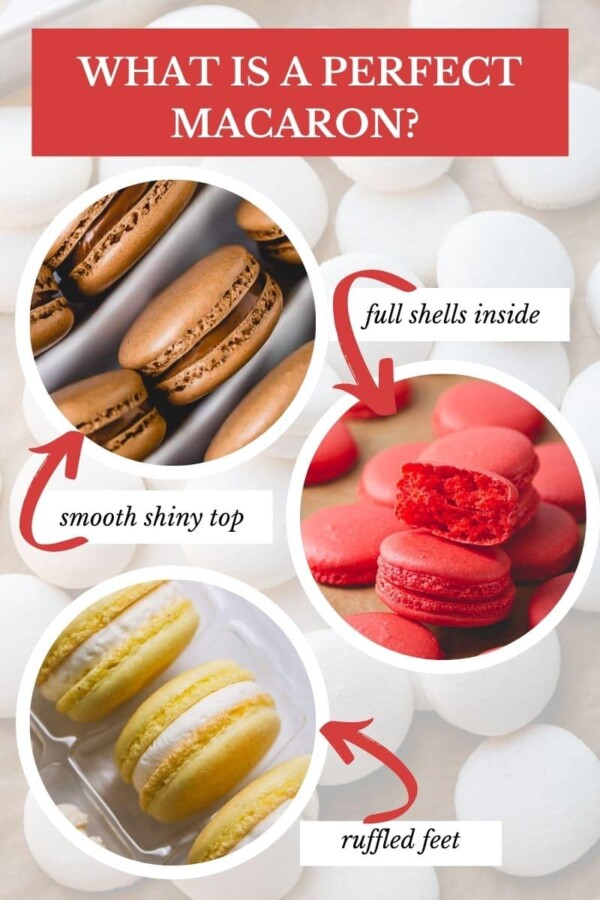
Macaron Troubleshooting Video
Visual Macaron Troubleshooting Guide
Ok, let’s discuss each of the most common macaron issues, their causes and how to fix or prevent them!
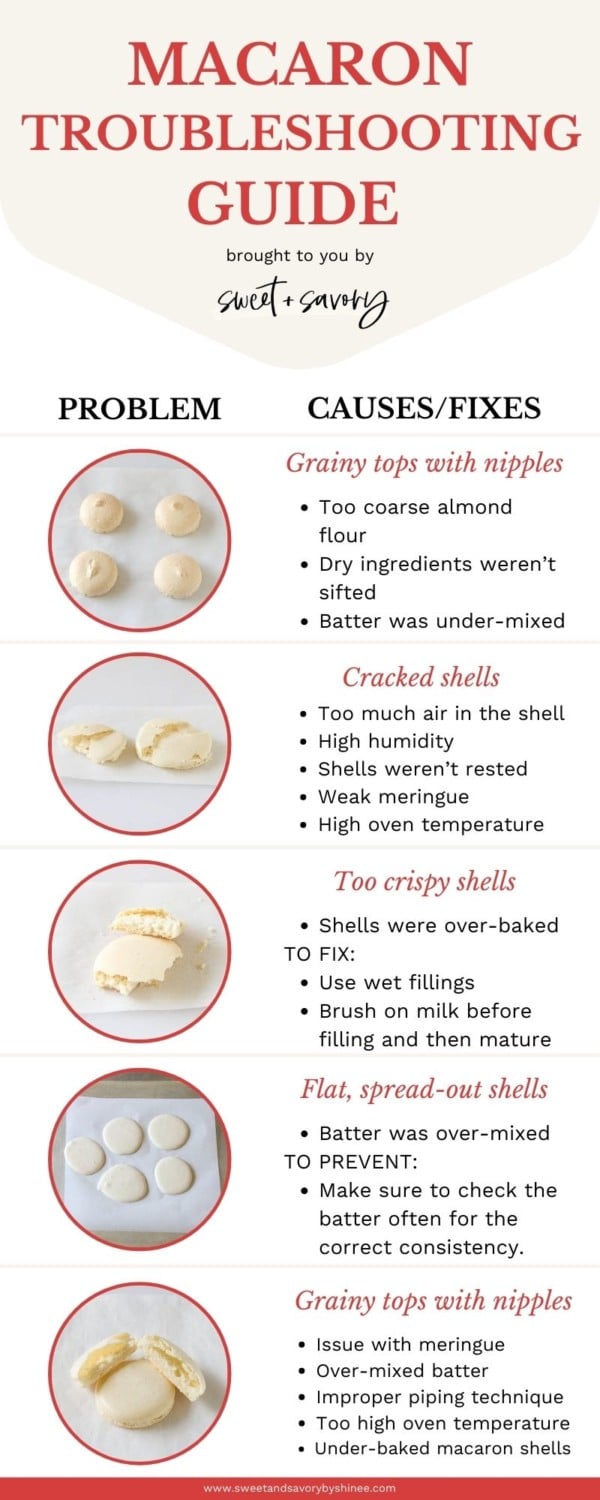
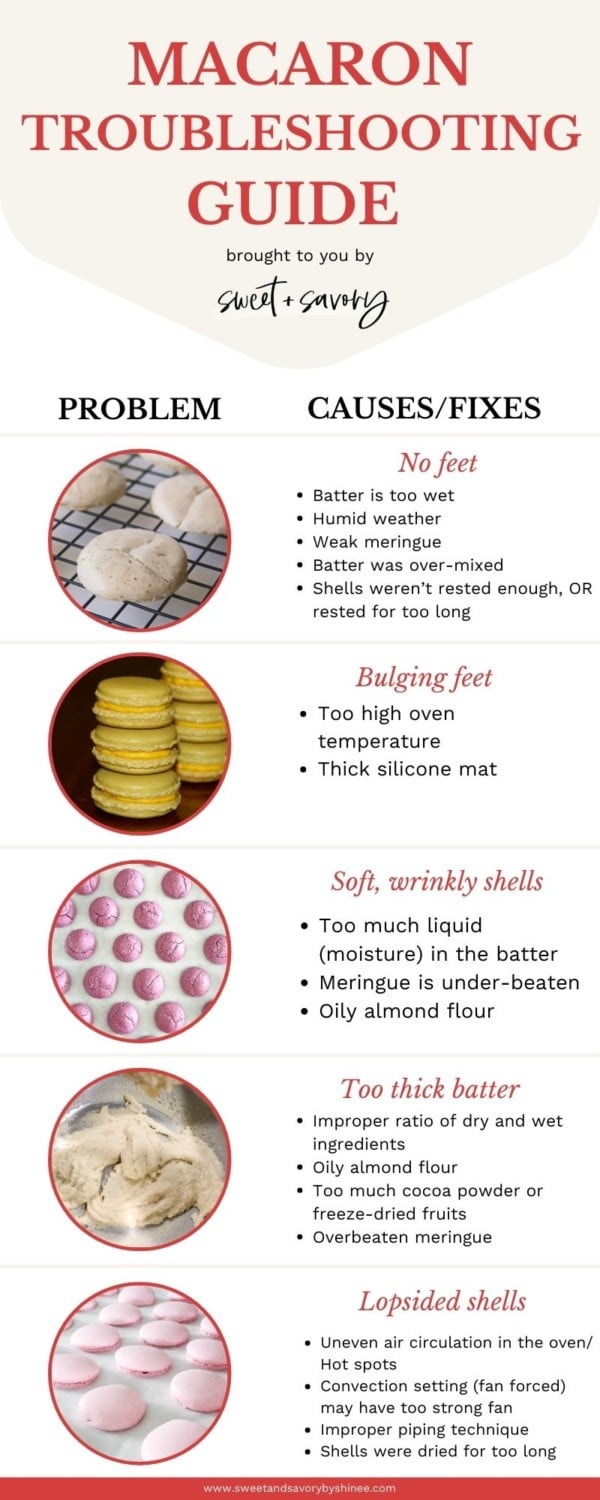
Pin this now to find it later
Pin ItUneven, grainy macarons with nipples
Possible causes:
- Too coarse almond flour
- Dry ingredients weren’t sifted
- Batter was under-mixed
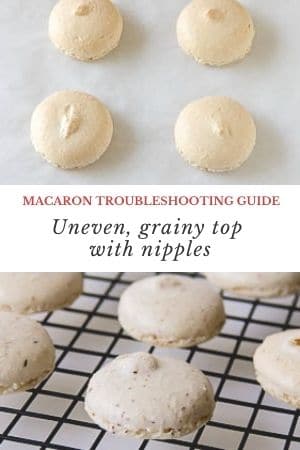
how to fix grainy shells with nipples:
- Make sure to use fine ground almond flour.
- Don’t skip sifting the dry ingredients! Toss large almond pieces left in the sifter. You shouldn’t have more than 1/2 tablespoon of almond bits.
- Under-mixed batter also causes grainy shells with nipples. When mixed right, the nipples should melt back into the batter after tapping the piped shells on the counter.
don’t do this!
Never use wet fingers to push the nipples down. Instead, use a toothpick to encourage the batter even out.
Cracked shells
Possible causes:
- Too much air in the shell
- High humidity
- Shells weren’t rested
- Weak meringue
- High oven temperature, or hot spots in the oven
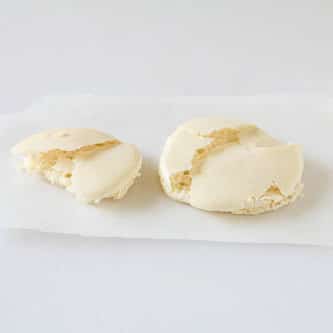
HOW TO FIX cracked macarons:
- Be sure to tap the baking sheet right after piping macaron shells. And use a toothpick to pop large air pockets visible on the surface.
- When it’s too humid, the shells don’t develop good skin, which leads to the next point.
- When the shells haven’t rested long enough to develop skin on top, steam releases from anywhere cause macarons to crack on top.
- Take your time to make nice and sturdy meringue, especially when you’re making French meringue. Watch my video on French Meringue 101 to learn all the tips to make the most stable French meringue.
- Too hot oven can also cause cracks in macaron shells. Make sure to get an oven thermometer to double check the temperature inside the oven without relying on what oven says.
Erupted shells
Possible cause:
- Touched the shells with wet finger to push down a pointy nipple
How to prevent erupted volcano macarons:
Never touch your unbaked macaron shells with wet fingers to push down pointy end. Instead tap the baking sheet well. And if the pointy end doesn’t melt into the batter, you can either baking them as is, or scrape the batter back into a bowl and mix for a little more until the batter is at correct consistency.
Too crispy interior
Possible cause:
- Shells were over-baked
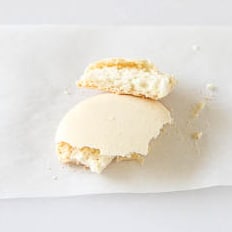
How to fix too crispy shells:
If you over-baked your macaron shells and now they’re super crispy throughout, don’t fret! 2 easy fixes:
- Use wet fillings, like jams, caramel sauce, or lemon curd in the center.
- Simply brush on milk on the bottom of the shells before piping a filling of choice.
Tip
Mature filled macarons for 24 hours. The shells will absorb the moisture from filling and macarons should soften nicely.
Flat shells, spread out too much
Possible cause:
- Batter was over-mixed
Over-mixed batter is too loose and the shells don’t hold its shape well, instead it spreads out too much.

How to prevent flat, spread out macarons:
Once macaron batter is over-mixed and it’s too runny, there’s no way to salvage it. So it’s important to prevent this from happening.
Make sure to check the batter often for the correct consistency. It should slowly run off the spatula into a ribbon, and the edges should melt back into the batter within about 10 seconds.
Hollow shells
Possible cause:
- Issue with meringue
- Over-mixed batter
- Improper piping technique
- Too high oven temperature
- Under-baked macaron shells
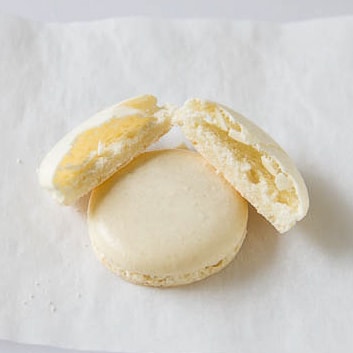
How to fix hollow macaron shells:
Hollow macarons are so common, and I personally battled with this issue for a long time. Now, I consistently get full, meaty macarons straight from the oven.
Since it’s a complex issue, I dedicated a separate post on how to fix hollow macarons.
No feet
Potential causes:
- Batter is too wet
- Humid weather
- Weak meringue
- Batter was over-mixed
- Shells weren’t rested before baking
- Shells were rested for too long, weakening the meringue structure
- Too low oven temperature
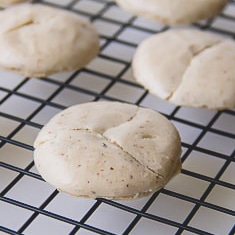
How to prevent no feet macarons:
- When the batter is too wet, macarons don’t develop those ruffled feet. The most common causes for wet batter: excess liquids, like extracts, lemon/lime juice, liquid food coloring, too much gel food coloring, etc.
- In some cases, especially in humid climates, aging egg whites might be beneficial. During aging, egg whites loose some of its moisture.
- When the meringue isn’t whipped to stiff peaks, it doesn’t have strong enough structure to lift macarons. Watch my French Meringue 101 video for visual cues for proper meringue.
- When macaron batter is over-mixed, there’s not much air bubbles left to give the shells lift during baking. Therefore, they come out flat without feet.
- Also, if macarons weren’t rested to form a skin before baking, it could cause no feet macarons. And if the shells were rested for too long, it can also negatively affect the batter, because meringue loses its stability when sat for too long. Keep checking the shells every 15 minutes and put them in the oven as soon as they don’t stick to your fingers.
- If the oven is not hot enough, macarons won’t rise as air bubbles in the meringue need heat to expand to lift the shells, creating that pretty feet at the base.
Tip
Make sure to get an oven thermometer to double check the temperature inside the oven without relying on what oven says.
Bulging feet
Potential causes:
- Too high oven temperature
- Silicone mat
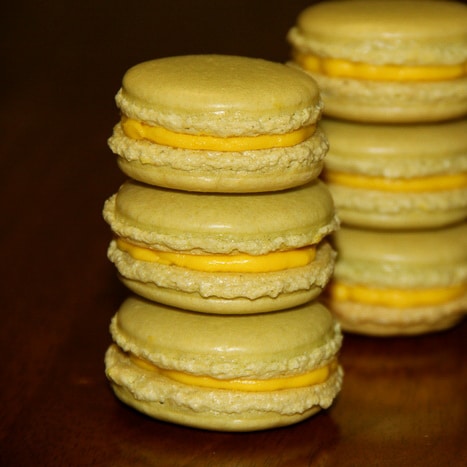
how to prevent bulging feet:
Some may find it ugly when the ruffled feet extends out of the macaron shells. I’m not a huge fan, but it’s not the worst!
- This happens when the oven is a bit too hot, causing the macarons to rise too high and then collapse slightly, making the feet bulge out.
- And another reason is silicone mat might be the culprit. I certainly happens to me with thick silicone mats, but I know some people have gorgeous macarons with silicone mats.
Soft, wrinkly shells
Possible causes:
- Too much liquid (moisture) in the batter
- Meringue is under-beaten
- Oily almond flour
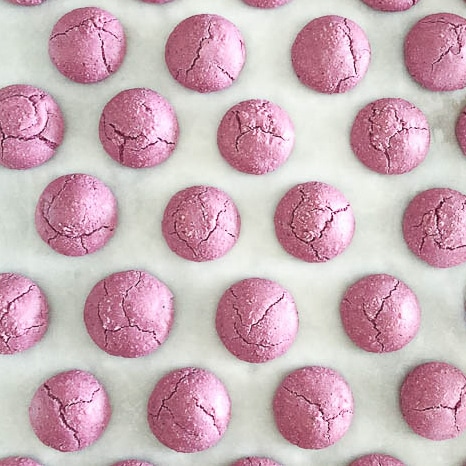
How to prevent soft, wrinkly shells:
Excess moisture and/or fat is the #1 cause for soft, wrinkly shells. And there’re number of culprits for excess moisture/fat in the batter:
- Adding liquid extracts, juices or liquid food coloring
- Adding cocoa powder, freeze-dried fruits, etc.
- Under-mixed meringue also contains too much moisture
- Oily almond flour, or almond flour that has been opened for too long
Cocoa powder contains fat which could potentially cause soft, brownie-like macaron shells. And freeze-dried fruits absorb moisture from the air fast and could cause soft, wrinkly shells as well.
Tip
Store opened almond flour in an airtight container in a cool place.
Too Thick batter
Typically, when you add dry ingredients into meringue, it starts out pretty thick and that’s totally normal. As you fold the batter, it thins out and gets runnier.
In rare occasions, the batter never loosens and it stays thick.
Possible causes:
- Improper ratio of dry and wet ingredients
- Oily almond flour
- Too much cocoa powder or freeze-dried fruits
- Overbeaten meringue
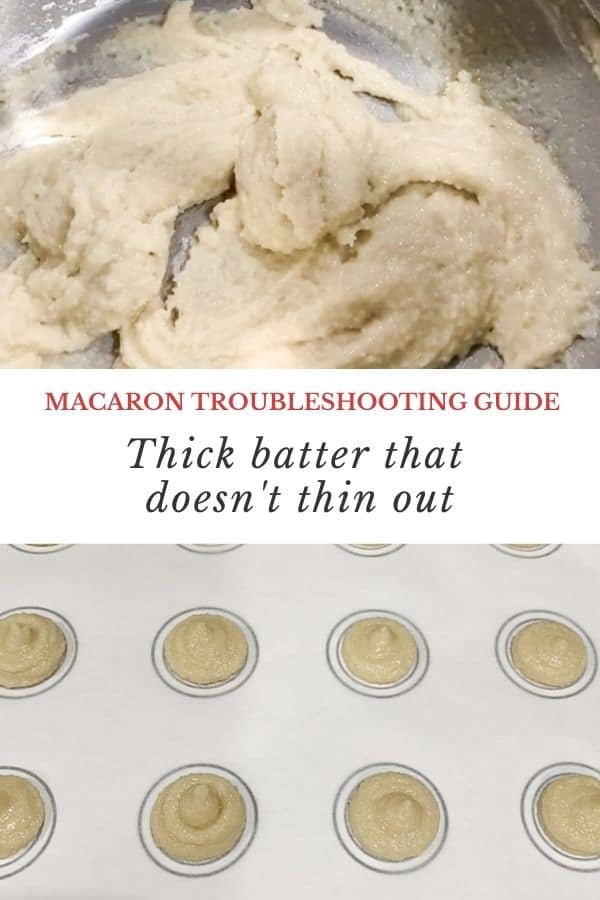
how to fix and prevent thick batter issue:
- Be sure to weigh the ingredients carefully. I strongly recommend weighing all the ingredients, including egg whites, with a kitchen scale.
- Oily almond flour could cause thick batter. Make sure to use fresh almond flour and avoid processing it in a food processor.
- Too much cocoa powder or freeze-dried fruits can throw the ratio of dry and wet ingredients.
- When meringue is over-beaten, it gets dry, throwing off the ratio as well.
Blotchy shells
I don’t have a photo of this issue, but basically it looks like greasy stains on the shells.
Possible causes:
- Oily almond flour
- Batter sat out for too long before piping
how to prevent blotchy macarons:
- Use fresh almond flour that’s not oily. To test, squeeze some almond flour in your hand and see if it holds its shape. If it holds its shape like wet sand, then it’s too oily.
- Make sure to pipe the shells right away, especially with French meringue batter.
Lopsided shells
Possible causes:
- Uneven air circulation in the oven/ Hot spots
- Convection setting (fan forced) may have too strong fan
- Improper piping technique
- Shells were dried for too long
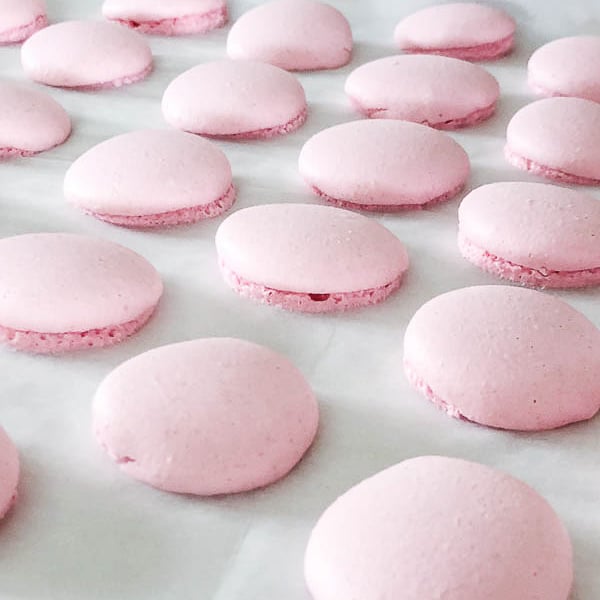
how to prevent lopsided macarons:
Main culprit for lopsided shells is poor air circulation. This could be due to uneven heat distribution and hot spots in the oven, convection settings with too strong fan. Here’re a few things you can do in this case:
- Flip the baking sheet upside down before piping macarons, so that there’s no edges around the sheet to block any heat circulation.
- Bake macarons one sheet at a time.
- Turn the baking sheet around half way through baking.
- If possible, bake on conventional setting, heat coming from top and bottom.
The next reason for lopsided macarons is improper piping technique. Pay close attention to following:
- Hold the piping bag with macaron batter straight at 90° and squeeze the batter from the top to one spot until the desired size reaches. Watch my macaron video for better illustration.
- Pipe the shells at least half an inch apart to give the shells enough room for air circulation.
And lastly, don’t dry your macarons for too long. Too thick skin may cause lopsided macarons.
Concaved (Inverted) shells or Stuck To Parchment
Possible causes:
- Low oven temp/ low heat from bottom
- Under-baked shells
- Not cooling the macarons before removing from parchment paper
How to prevent concaved, or stuck macarons:
- Make sure your oven is hot enough. Most of the time, ovens need good 30-45 minutes to preheat properly. Even if it beeps when it’s preheated, I highly recommend double checking with an oven thermometer.
- Be sure to check the macarons for doneness before taking them out. To test for doneness, gently touch the top of one macaron with your index finger and try wiggle it. If it wobbles side to side, they’re not ready. keep baking for another minute or so. The cooked shells should wiggle ever so slightly and firm to touch. When in doubt, cook a bit longer. In my opinion, it’s better to over-bake them than under-bake them.
- Make sure to cool the macarons on the baking sheet for at least 10 minutes before removing from parchment paper/silicone mat.

Whew, are you still with me? Thank you!!! I hope this macaron troubleshooting guide answers your questions and helps you to perfect your macaron skills.
And if there is anything I haven’t covered, please leave me a comment below. I’d like us, macaron-lovers, connect and discuss various problems we face baking macarons. Let’s get the discussion started.
More Favorites from Sweet & Savory
This post was originally published on December 21st, 2015, and last updated on February 16th, 2021.



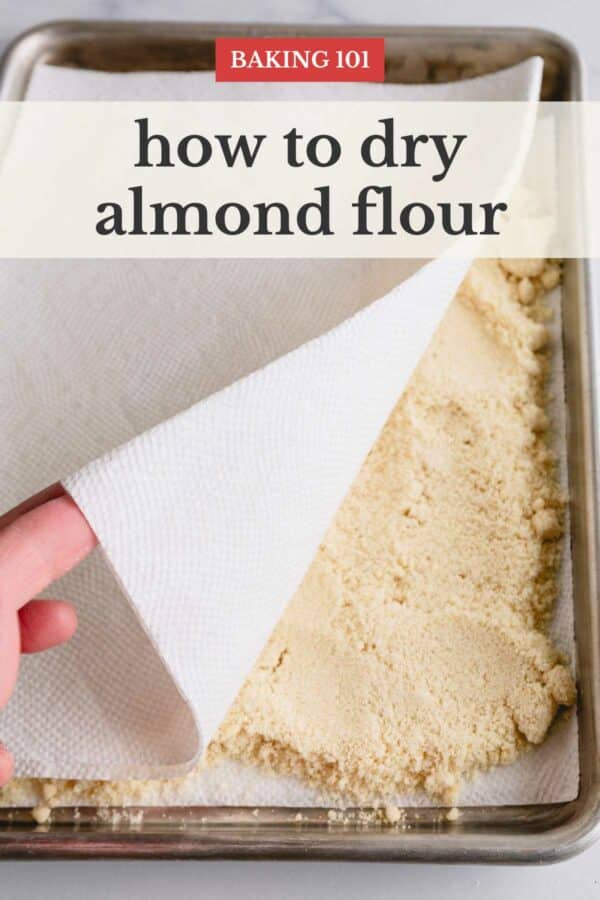


Hi Shinee,
I have made several batches of macarons during quarantine, and have to say Ive had pretty good luck. I used your and another blogs recipe who had very similar recipe/weights etc. I have not had any problems with cracks or hollows, or missing or spread feet and mine look great however, each batch has been on the chewy side. The outer shell isn’t crunchy… im still thrilled with the results but am wondering how I can fix to make the outer shell a little crisper without overbaking. I have reduced my oven temp… I started on 300 convection and am now down to 285 for 14 minutes. I’ve had a hard time finding results for just chewy macarons… Thank you so much. I enjoy browsing your pages very very much.
Hi, Cynda. Thank you for your review and feedback. Do your macarons have smooth shells? Or are they soft and wrinkly? Or they have smooth shells, just not crisp? It maybe due to almond flour, if it’s a bit on oily side. I’d suggest trying different almond flour and see if that helps.
Thank you so much for your reply Shinee. My shells come out smooth and shiny and to look at they look perfect. But when you bite into them (after maturing) the shells are soft and chewy. If thats the worst then i think Im still doing good but would love to perfect that crispness for the shell. Hmm, we did just get a new brand of almond flour. I am def going to try a different brand and see if that helps.
Hi, Cynda. I think you’ve got a perfect macaron. Your photo looked perfect. I think it’s normal for the shell to soften after maturing.
I could not fold the batter enough it seemed, gave up after 80 or so folds. It always was thick. Pretty sure I did not overbeat the egg whites. I tried twice. Both batches tasted good but I think too much batter in each cookie since so thick. Will try again tomorrow.
Hi, Susan. Did you weigh the egg whites? I ran into thick batter issue when I used less than 65gr of egg whites.
I used the Scran Line’s recipe, I might try yours next time, but my macarons came out really dense. The taste is great and the texture is super close, but they don’t have that nice crispy outside and they’re a smidge too dense inside. I kept the oven at 300 F and only kept them in there for about 15 minutes, so I think it must have gone wrong during the mixing stage. Any advice?
Hi, Cecilia. I’m not sure what you mean by dense? You do want your macarons full inside. Maybe you meant they’re like wet, sticky inside? Also it’s hard for me to troubleshoot the issue, as I’m not familiar with your recipe.
Thank you so much for the tips!
You mentionedthat there may be 2-3 tablespoons of the larger pices of slmond flour. Does it need to be replaced? Would it be s better idea to sift the almond flour to eliminate these pieces?
Hi, Lulani. If you have no more than 2 tablespoons of almond chunks, then you don’t need to replace it. But if you get more than 2 tablespoons, then yes, add more almond flour. We’re sifting almond flour and powdered sugar for 3 purposes: 1. get rid off the large chunks. 2. aerate the dry ingredients. 3. mix the dry ingredients. In my experience, I never got more than a teaspoon of large chunks of almond flour. So a good quality almond flour makes a difference.
Hi,
Thank you for your sharing. After countless attempts I finally came up with something that l somehow looks like macarons. However, there are still some missing here:
•The shells are hollow
•Some of them cracked in the oven
•Some of them have uneven feet
I did not over whip the white or over work the batter, I also bang the tray right after piping and I baked mine at 300°F for 7mins then turned down to 265°F for 15mins.
Can you help me with these? Thanks a lot 😁
I have not tried to make your recipe yet but I did make my first macarons almost 2 weeks ago and they actually turned out pretty good! My 2nd attempt was this past weekend and they were a total fail except for the taste ☺ I made an Italian meringue and added melted chocolate just like the recipe said to but the wouldn’t dry and they spread out like lace cookies! I think there was too much moisture in my house because I was at a friend’s house the first time I (we) made them. Please tell me using melted chocolate in the shell batter will actually work, I want to make them for a chocolate cookie contest!
I made it as directed but the shells were hard and inside still gooey so I cooked longer and it remained gooey. Any ideas what could be the problem? It also seemed hard and not at all cakey like in your pictures! 👎
Oh no, Kati. It sounds like your oven may be running hotter. Do you have a oven thermometer to check the accuracy? I highly recommend getting this super inexpensive oven thermometer to keep it in your oven to monitor the temperature. Because it’s very normal for ovens run hotter or cooler up to 50°F, which could be a big deal breaker for baking macarons.
My 1st attempt at macarons was the ultimate fail and went directly into the trash. The next day I tried again with slightly better results. Then I found your troubleshooting guide to macarons. Since my problem seems to be over beating the merengue the 3rd attempt should be better. Thank you.
Hi!! I’m just wondering if it’s necessary to add more almond flour after sifting? A majority of the time, there’s a few tbsp that are too big to be sifted so I’m worried that the consistency will be off if i leave the clumps out 😅
Hi, Joohyun. I never replace the discarded portion as long as it’s no more than 2 tablespoons. So if you have like more than 2 tablespoons of almond flour in the sifter, I’d suggest add 1-2 tablespoons of almond flour. Hope this helps.
Hi,
I have had many attempts making macarons and I have had no luck. My macarons always are cracked, even though I rapped the tray. They are spreading, even if my batter is thick or is the right consistency, and they are hollow. I have tried many things but they have not worked. Also I have a lot of trouble at identifying what a proper meringue looks like and what a good batter looks like. Can you help me? Thanks a lot.
Hi, Jade. Thanks for reaching out! And kuddos to you for not giving up on macaron making!! It sounds like you’ve got lots of different issues going on. But before I begin troubleshooting, I’m wandering what recipe are you using? If you haven’t already, I highly recommend trying my basic macaron recipe. That way our troubleshooting will be consistent and more productive.
And a few quick notes about the issues you’re experiencing. Cracked macarons are typically due to over-mixed batter, so are the spreading issue. If your macaron batter is the correct consistency, your shells should not spread too much.
In my white macaron recipe, I shared how meringue looks like at soft-peak and hard-peak stage.
You can also watch my video tutorial for batter consistency. Hope this helps. Let me know if you have any more questions. Good luck!